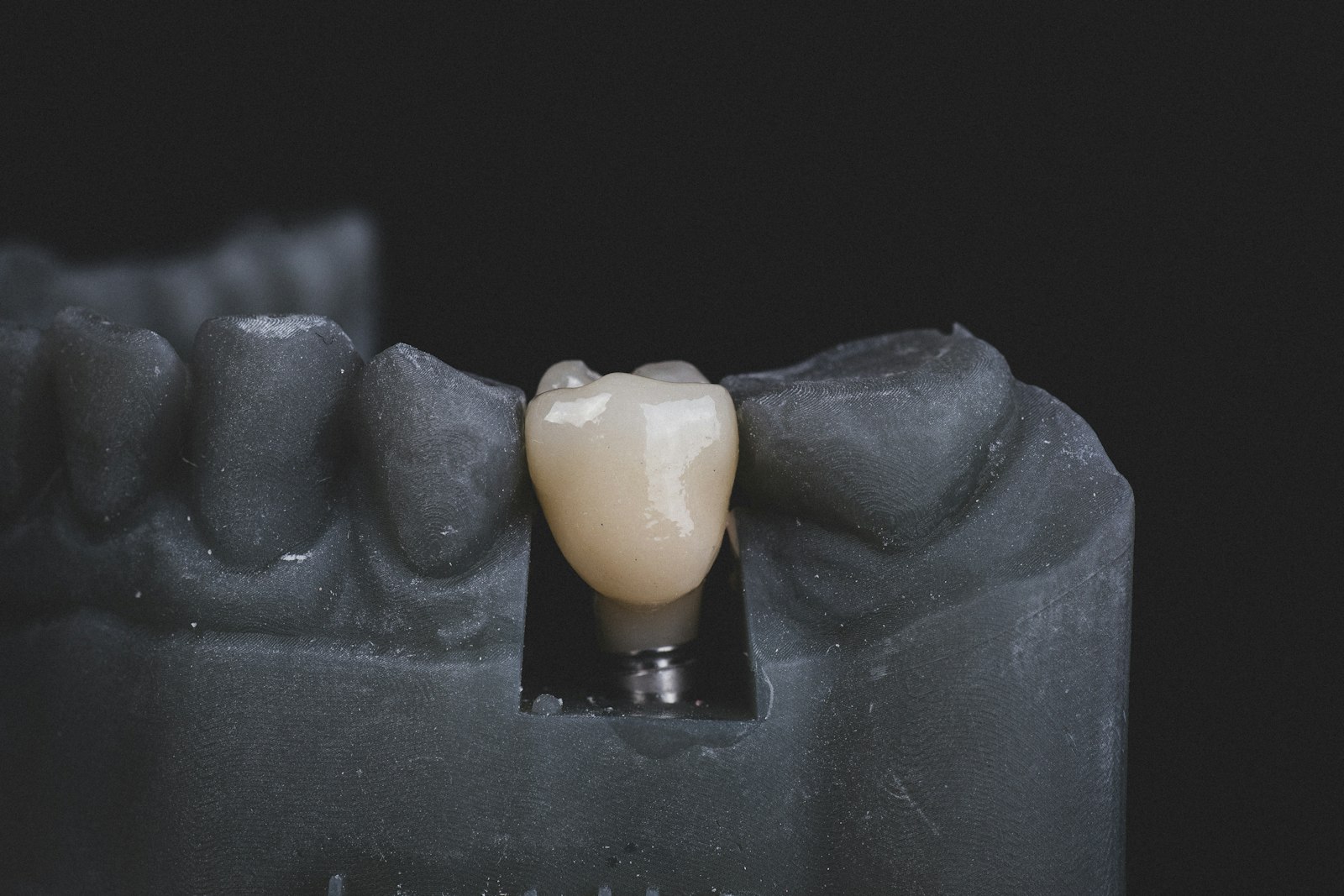Search engine optimization (SEO) may seem abstract, but it's becoming increasingly important for dental practices looking to grow their patient base and boost visibility online. With more patients turning to Google, Bing, and other search engines to find nearby dentists, having an optimized website and online presence is critical to standing out from the competition.
You can no longer rely solely on word-of-mouth or drive-by visibility to attract new patients. An astonishing 97% of people look for local businesses online. For dental practices, this presents a significant opportunity to showcase your services. It also allows you to highlight what makes your practice unique. But with more dentists focusing on SEO, simply having a website is no longer enough. You need one that is designed and optimized for how patients search for care in your area.
This guide covers dental SEO best practices. Implementing them can significantly impact the growth and success of your practice. SEO should be a foundational piece of your overall digital marketing strategy. It drives high-quality website traffic, builds local authority, and boosts conversion rates.
Understanding the Basics: What is SEO and Why it Matters for Dentists
Before diving into strategy, let's quickly cover SEO basics, starting with a definition.

Defining SEO in the Context of Dental Practices
SEO or "Search Engine Optimization" essentially means optimizing your online content and profiles to rank better in search engines like Google and Bing. By implementing specific SEO strategies, you can move your website and online listings higher in the search results for relevant keyword phrases. This allows you to put your dental practice before more prospective patients actively searching for care.
For dental practices specifically, key SEO objectives typically include:
- Appearing on the first page of search results for dental-related terms like "emergency dentist [city]" or "cosmetic dentistry [city]."
- Outranking competitor dentists in local search results
- Building online visibility and authority around specific dental services you offer
- Driving more relevant organic search traffic to your website
- Increasing phone calls and conversion rates from that web traffic
Achieving high search engine rankings for these relevant terms ultimately helps you generate more new patient appointments and grow your practice.

The Impact of Strong SEO on Patient Acquisition and Retention
So why does SEO have this powerful impact, and why does it matter from a business revenue perspective? There are two key reasons:
1. SEO drives more qualified website traffic
Unlike paid ads, which can attract random traffic, SEO delivers targeted visitors already searching dental-related keywords and topics. For a dental practice, this incoming traffic is much more likely to convert into genuine patient leads and appointments. In fact, search engine traffic has three times higher conversion rates on average compared to other referral sources.
2. High rankings build visibility and trust
Appearing on page 1 of search engines for highly searched keywords demonstrates authority and trust. People assume that practices ranking the highest must be credible providers. This perception then further boosts conversions and retention once visitors become actual patients.
In total, the traffic and credibility gains that SEO delivers translate directly into impact on key dental practice KPIs:
- Increased new patient appointments. More phone calls and contact form leads driven by organic search traffic to your website.
- Higher case acceptance rates. Improved trust and perception, thanks to high rankings, build patient confidence.
- Lower patient acquisition costs. The incremental traffic SEO provides is essentially "free" once campaigns are set up.
- Stronger patient retention. More existing patients seeing your practice appear prominently online after initial appointments.
The numbers here can be staggering. According to recent surveys, on average, each first-position gain in local SEO search rankings delivers a 14% increase in clicks and calls. Meanwhile, for specialized healthcare searches, 42% of clicks go to the #1 position.
In other words, being on the coveted first page - and ideally in the first organic slot - pays significant dividends for dental practices focused on growth.
Let's begin making this SEO visibility happen for your practice, starting with researching the best keywords intelligently.
Keyword Research: Finding the Right Terms for Your Dental Practice
The foundation of executing an effective SEO strategy for dental practice lies in identifying and targeting relevant keyword phrases. But with the extremely high search volume around dental issues, how do you determine which specific terms to focus on?
This begins with formal keyword research - gathering hard data on search trends and analyzing how your competitors rank for dental keywords in your area.
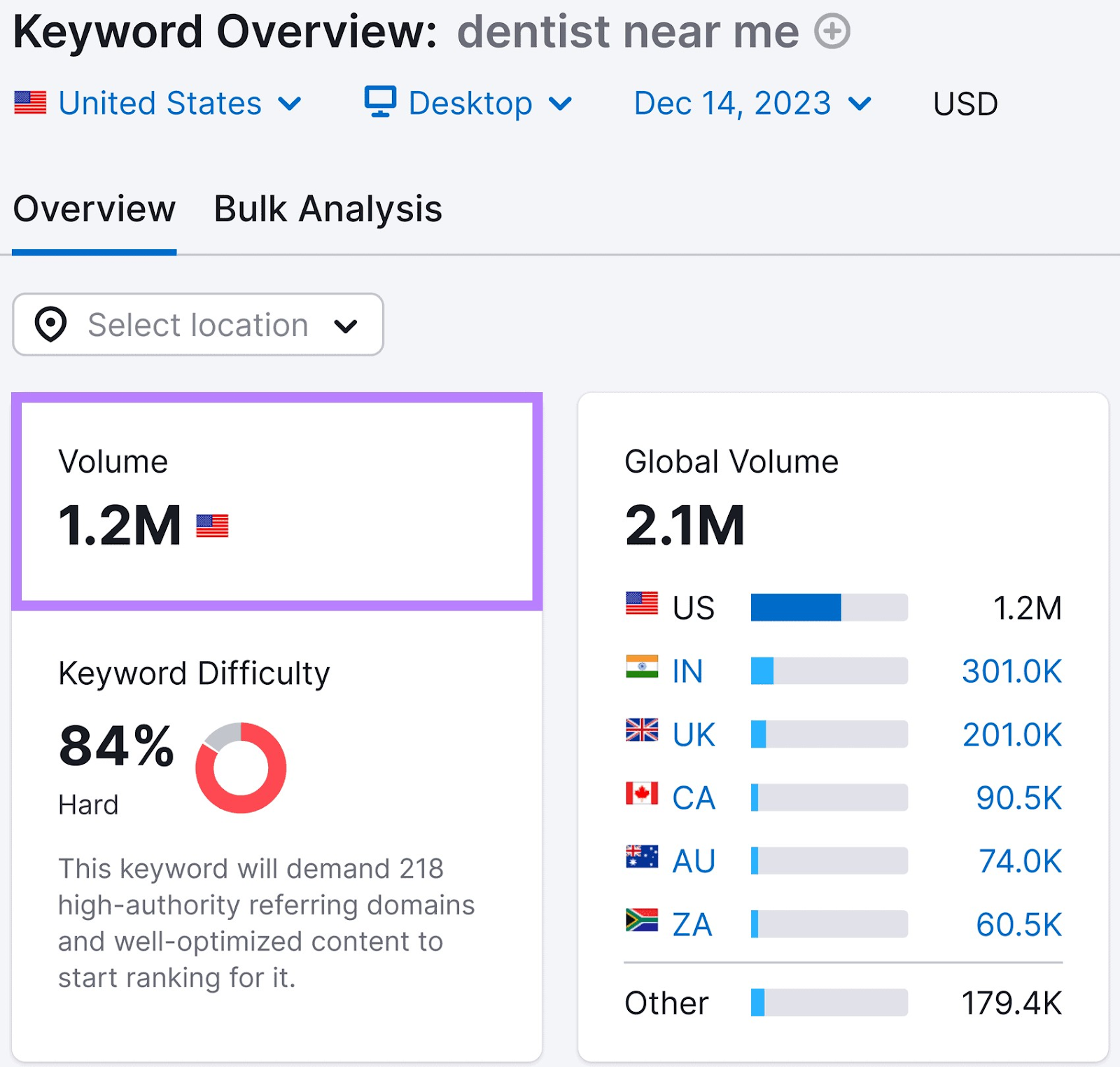
Tools and Techniques for Effective Keyword Research
Comprehensive keyword research should assess two distinct aspects:
1. Keyword search volume and growth trends
You first need visibility on metrics like:
- Monthly/annual search volumes for target dental phrases
- Actual search trends - which terms are rising or falling?
- Click-through-rates (CTR) for rankings on result pages
- Related/alternative terminology people search
The top tools to benchmark these metrics include:
| Tool | Key Features |
|---|---|
| Google Keyword Planner | Volume and trend data on actual Google searches |
| SEMRush | In-depth keyword data plus click-through-rates |
| Google Trends | Identify rising/falling search trends over time |
2. Analysis of competitor dental SEO strategies
Equally important is researching what similar dental practices target for keywords locally and how they rank. Useful metrics here include:
- Which keywords do competitors rank for
- What pages/content target each term
- Optimize ranking positions/first-page ownership
Top competitive research tools include:
| Tool | Key Features |
|---|---|
| SEO SpyGlass | Competitor keyword ranking analysis |
| Ahrefs | Identify competitors’ SEO strategies |
| OpenSiteExplorer | See actual backlinks driving rankings |
Combining hard keyword data from both perspectives allows you to create a customized SEO plan for your practice, identifying the specific terms that present the most opportunity.
Analyzing Competitor Keywords and Strategies
As highlighted above, reviewing proven SEO strategies from other dentists in your area is crucial prep work.

For these competitor analyses, ask:
- What core services do they focus on attracting patients for? How do these align with your offerings?
- What types of keywords are tied to their top-performing website pages and content?
- Who ranks highest in local pack results for relevant keywords?
- What factors like links, citations, or reviews contribute to their high rankings?

Competitive analyses then let you:
- Model what works well locally around SEO
- Provide keyword ideas tied directly to converting patients
- Strategically target terms competitors may be missing
- Build differentiated SEO campaigns apart from other dental practices
Remember that competitors ranking well locally likely indicate substantial search volume and intent for those keywords. Identifying these terms that clearly convert patients for other practices in your geography ensures you know which SEO investments will similarly pay off.
Let's focus on SEO, specifically your website, starting with overall site structure and content.
On-Page SEO for Dental Websites

While off-page SEO driving links and citations is critical, you must ensure your website meets technical and content best practices. Well-structured sites send clear signals to search engines on relevance around target keywords, influencing rankings.

Optimizing Your Website's Structure and Content
Foundational areas to optimize on-page include:
URL Structure
- Descriptive URLs with target keywords (e.g., www.dentalpractice.com/cosmetic-dentistry)
- Simple URL structure using dashes/hyphens, not underscores
Internal Site Linking
- Links from supporting pages to key service pages with focus keywords
Content Structure
- Heading tags (H1, H2, H3) incorporating keywords
- Related images/media for each page with descriptive filenames
Page Loading Speed
- Image compression and minification to accelerate load times
- Eliminating render-blocking elements
Mobile Optimization
- Responsive design and accessible content on mobile devices
Schema Markup
- Structured data for FAQs, products/services, office info
Optimizing these technical elements helps search bots better crawl, index, and understand your pages about specific dental keywords and phrases.
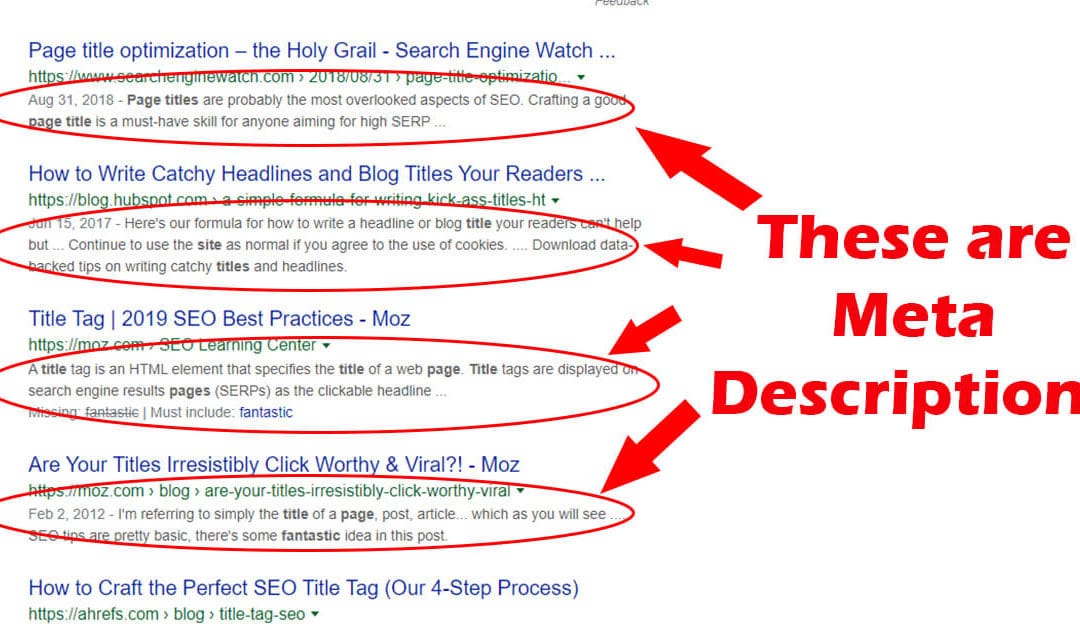
Best Practices for Meta Descriptions, Headings, and Tags
In addition to site structure, the actual written content and HTML tags used on each page significantly impact SEO effectiveness. Best practices to leverage include:
Page Titles
- Incorporate the primary focus keyword for each page
- Concise titles with 50-60 character length
Meta Descriptions
- 160-character snippets with page summaries
- Include secondary keywords/phrases
Content Sections
- Multiple H2/H3 headings tying back to keywords
- Related keyword mentions in paragraph copy
Alt Text
- Descriptions for all images on the page
- Additional keyword insertion opportunity
The cumulative impact of these on-page elements and technical site optimization informs search engine crawlers on what each page focuses on. You can significantly improve relevance for those searches by directly tying this to targeted keywords.
Let's shift our discussion to off-site optimization and building external signals demonstrating expertise and trust for your practice.
Off-Page SEO: Building Authority and Trust
While on-page SEO creates strong website foundations, additional off-page signals influence search rankings significantly. Off-page optimization in areas like backlink acquisition, local listings, and reviews can drive top search visibility over time.

The Role of Backlinks and How to Acquire Them
Backlinks represent one of the most powerful ranking factors search algorithms use today. These external links pointing back to pages on your website essentially act as "votes," demonstrating authority and trust.
And much like the on-page elements above, backlinks work best when they:
- Point to relevant pages tied to target keywords
- Come from highly authoritative sites in your industry
- Use proper anchor text aligned to focus terms
The top ways dental practices accumulate high-quality backlinks include:
Industry Directories & Associations
Listings on sites like the ADA and others linked using branded names or keywords.
Referral
Listing pages on allied health partners like medical practices, fitness clubs, etc.
Local Sponsorships
Sponsor local events and have listings on their websites.
Guest Posts
Contribute guest articles to industry blogs using branded anchor text links.
Reviews
Positive reviews on sites like Yelp and Facebook also build SEO value through backlink equity passed.
First, list claimed profiles across key directories and fill out all possible practice details before exploring additional link-building tactics like guest blogging outreach.
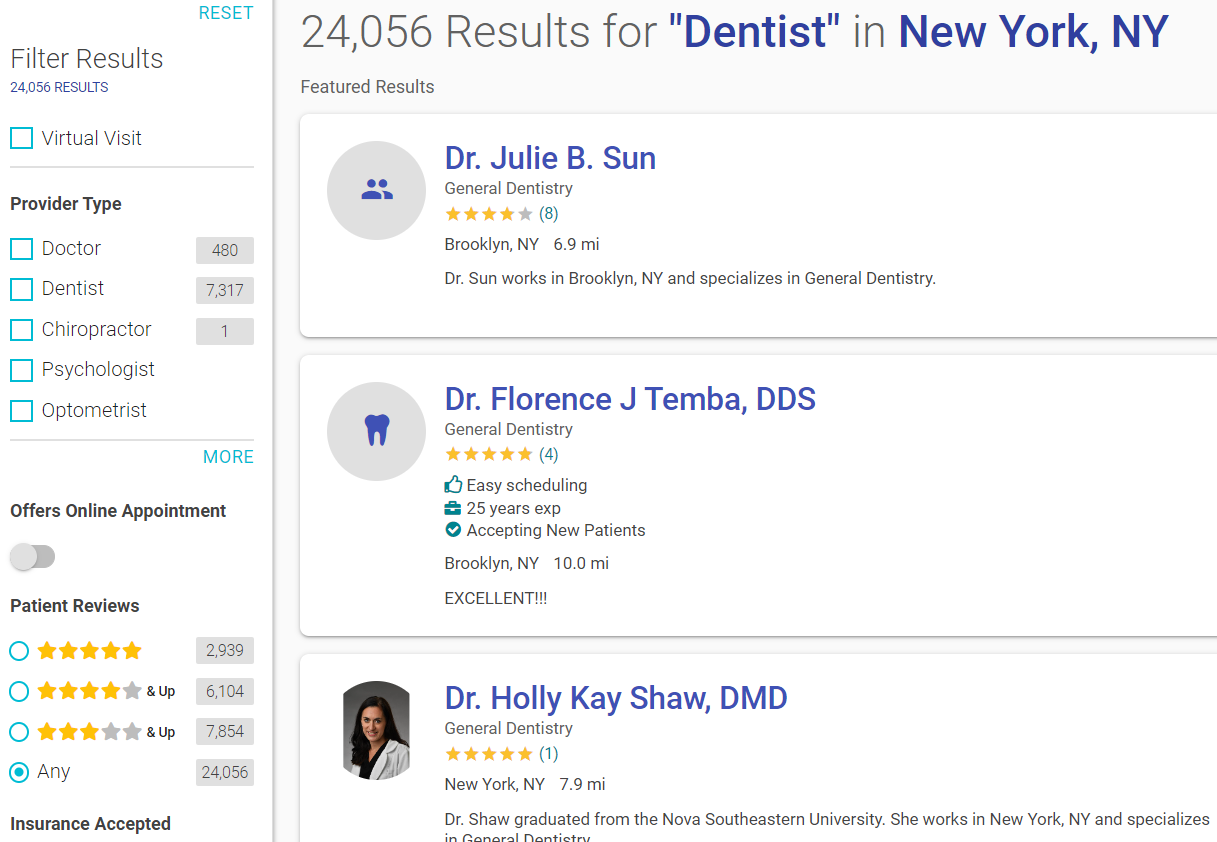
Leveraging Local Listings and Reviews
Expanding beyond backlinks, local listings, and customer reviews further signals a solid local presence to search engines.
Having complete and consistent NAP profiles (name, address, and phone numbers) registered across major sites helps associate your practice with searches in the surrounding area.
Top dental listing directories include:
- Google My Business
- Apple Maps
- Bing Local
- Yelp

Similarly, generating more positive customer reviews on these sites builds tangible SEO value. By driving higher star ratings and more quantity feedback, search algorithms infer greater local authority.
Both robust listings and reviews enhance local pack and map rankings for searches around key dental services and issues for your metro.
Now, let's explore how creating engaging, informative content for your website visitors can further accelerate SEO growth.
Content Marketing Strategies for Dental SEO
Crafting quality blog posts, FAQs, and videos designed specifically for potential dental patients offers multiple SEO advantages. These include:
- Pages and media focused on target keywords
- Internal links to pass equity to service pages
- Backlinking opportunities from shares
In other words, content marketing attracts search traffic directly while amplifying other optimization efforts.

Creating Engaging and Informative Blog Posts
Blog content represents the foundation here, with dental practices able to educate prospective patients and address common questions at each stage of their buyer's journey:
Awareness Stage
Articles like:
- When is it time to see an emergency dentist?
- Top 10 signs you may need cosmetic dental work
Research Stage
Posts such as:
- Five crucial questions to ask at your dental exam
- Understanding dental insurance plans and coverages
Decision Stage
Guides covering topics like:
- Evaluating the competency of cosmetic dentists
- Comparing types of dental implants
Spreading content across categories touches visitors at different decision-making spots - all linked back to website service pages for conversions.

Video Content: A Growing Trend in Dental Marketing
Increasingly, patients now seek out videos for healthcare information online. Creating bespoke video content presents opportunities to showcase your practice further while targeting high-value SEO keywords.
Possible dental video content includes:
- Practice tours and introductions
- Patient testimonial compilation reels
- Doctor videos answering common questions
Publishing videos natively on YouTube or your site provides additional relevant signals and directly surfaces this engaging content in Google universal search results.
Delivering beneficial information via blog and video content attracts and nurtures potential new patients over time via SEO. Next, let's examine tracking performance of these collective efforts.
Measuring SEO Success: Key Metrics and Tools
Of course, the end goal for any SEO campaign is driving actual growth and profitability gains for your dental practice. The final step is implementing processes to monitor effectiveness across the strategies mentioned above.
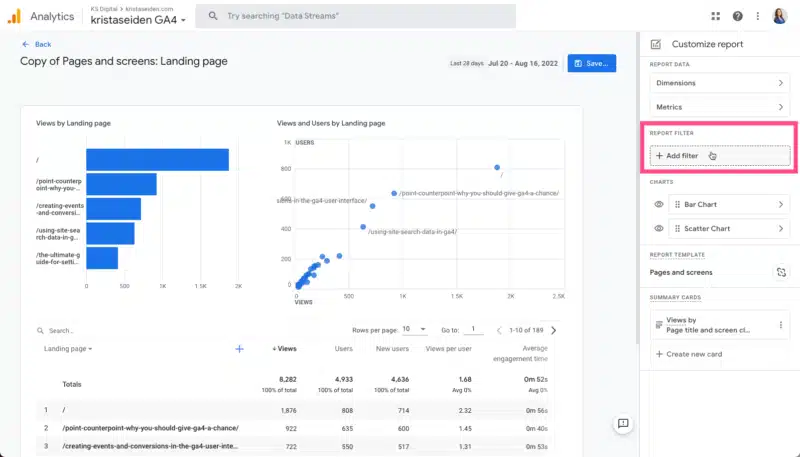
Tools for Tracking SEO Performance
Robust analytics integration is essential here for tracking core metrics like:
Rank Tracking & SERP Monitoring
- Keyword rankings and ranking changes over time
- Landing page positions (organic vs. local pack)
- Ranking velocity and patterns
Organic Traffic & Lead Volume
- Total visitors and pageviews from organic search
- Conversions from phone/form leads
ROI Impact
- Source/medium reporting on patient acquisitions
- Actual new patient appointment revenue attributed
Free versions of tools like Google Analytics, Google Search Console, and Semrush provide solid baselines. Advanced paid solutions like Raven Tools, Bright Local, and Moz add more custom reporting capabilities.
Interpreting Data to Refine Your SEO Strategy
Analyzing your SEO analytics allows you to identify what's working well while rectifying poor-performing areas.
Key insights to examine include:
- Which specific landing pages drive conversions? Optimize these further.
- What keyword phrases show the most impressions and clicks? Pursue higher rankings.
- How does SEO traffic quality compare to other channels? Shift the budget accordingly.
- Where do visitors exit your site? Look for page experience improvements.
Continually refining your strategy based on hard metrics ensures SEO keeps contributing meaningfully to dental practice growth and profitability over the long term.
Conclusion & Next Steps
As competition for dental patients intensifies, mastering SEO delivers a proven pathway to increased visibility and website traffic. The comprehensive tactics covered here highlight the breadth of optimization work involved - from targeting the highest potential keywords to building trusted backlink profiles and maximizing on-page content.
While advancing SEO can take sustained effort over months, incremental progress inevitably builds towards higher search rankings, more quality leads, and, ultimately, business revenue growth. For practices focused on profitability, SEO delivers unmatched returns compared to other patient acquisition channels.
The tips here offer a starting point for dentists ready to expand their online presence. For hands-on execution support or complimentary SEO audits, our dental web marketing team provides specialized expertise explicitly tailored to the dental industry. Reach out anytime to strategize further.
FAQ
1. What are the most important ranking factors I should focus on to improve my dental practice's SEO?
Google's ranking algorithm takes into account over 200 different signals. But based on multiple algorithm analysis studies, the most influential on-page factors include:
- Keyword optimization in page titles and H1/H2 headers tags
- Quick page load speeds and full mobile optimization
- Backlink equity passed to pages from internal links
- Positive user engagement metrics like time-on-page
For off-page factors, the top drivers are:
- Authority passed from high-quality backlinks
- Complete and consistent NAP profile citations
- Quantity and quality of local reviews
Start by tackling foundational elements like titles/headers, page speed, and technical citations. Then expand into more advanced link-building and review generation efforts.
2. What is an ideal process for researching target keyword opportunities?
An effective SEO keyword research process follows these key steps:
- Identify Wide Keywords: Use tools like Google Keyword Planner for volume checks first on broad seed terms like "cosmetic dentistry" or "dental implants".
- Refine Into Focused Phrases: Review metrics like Competition and CPC data in Keyword Planner for more segmented long-tail versions like "ceramic dental implants pros and cons" or "best techniques laser dentistry whitening".
- Localization Opportunities: Adapt selected keywords inserting surrounding city/region names like "sedation dentistry Austin TX area".
- Competitor Benchmarking: Search for your shortlisted keywords in Google itself and assess what types of sites rank well already. Identify SEO gaps.
- Traffic Potential Validation: Google organic traffic estimates in Keyword Planner for finalized lists to quantify search volume opportunity.
This process ensures you select both high-potential volume and high-relevance keyword targets.
3. If I want to rank for 5 primary focus keywords, how many pages of optimized content should I create?
For 5 main keyword targets, plan to develop:
- One primary services page fully optimized for each individual keyword. This allows laser focus with optimization elements like page titles, headers, content, etc. all expressly aligned to each phrase.
- Three supporting content pages for each core target keyword also. These secondary pages play assisting SEO roles with relevant content passages, images, links pointing back to the primary pages.
So with 5 core SEO keywords, create 5 specifically optimized dental service pages along with 15 articles, FAQs, etc. reinforcing those topics. This collective cluster of content centralizes authority to lift rankings for your selected terms.
4. What types of off-page signals influence local pack rankings the most?
Google and other search engines display local pack listings prominently for location-based searches like "dentists near me". Key off-page signals driving visibility here include:
- NAP Citations: Listings on directories like Yelp and industry sites matching your business name, address, and phone number.
- Categories: Properly categorizing listings (like "Dentist" and specialization tags) on citation sources.
- Reviews: Quantity and quality of ratings/reviews on third-party sites like Facebook and industry profiles.
Ensure you claim and complete listings on 50+ relevant directories with all details fully consistent. Generate genuine positive reviews centered around customer service and quality of care. This earns local pack prominence.
5. Is guest posting still an effective link-building tactic? What quality standards should I have?
Yes, guest posting remains a worthwhile content marketing and SEO asset. But due to past overuse, securing placements now requires ensuring contributed articles meet specific quality conditions:
- Original, non-duplicate content: 100% unique writing adding tangible value for blog readers. No scraped or spun content.
- Detailed, nuanced writing: Thorough analysis and explanation on selected topics rather than short generic blurbs.
- Proper contextual alignment: The blog your article runs on should connect logically to your dental practice in some capacity.
- Restrict link inclusion: Do not over-optimize links back to your website in guest posts. One contextual mention is sufficient for SEO value.
By contributing truly useful dental industry insights to quality blogs under proper guidelines, guest posts retain SEM potency without venturing into manipulative territory from Google's assessment.
6. What is an ideal timeline to expect noticeable SEO results when starting from scratch?
In today's competitive SEO landscape, reasonable timeline expectations to see organic search traction for new dental websites generally follow:
- Month 1: Complete technical SEO foundations like site migration, resolving indexing issues, page speed optimizations, establishing analytics.
- Months 2-4: Target local low competition keywords to gain initial rankings, traffic, and GMB rankings. Pursue low-hanging fruit opportunities.
- Months 5-8: Expand to more difficult national keywords and larger topic clusters. Pursue link-building and conversions optimization.
- Months 9-12: Establish consistent rankings in competitive keywords and local SERP dominance. Expand content silos and derivatives.
Depending on how aggressively you pursue the right strategies month-over-month, significant organic search growth - even in competitive spaces - can still materialize within a 6 to 12 month period. But achieving true authority requires a steady, staged approach over this full year timeline.
7. How long should it take before I see SEO positively impacting my new patient appointments?
Beyond general SEO traction timelines, when examining specific dental KPIs like new patient appointments, you can reasonably expect to start seeing measurable lifts within 6 months following basic SEO best practices.
After initial technical optimization, sites begin ranking for some basic keywords driving incremental website traffic after 1-2 months typically. From there allowing 3 months for this SEO traffic to convert through calls/form fills, you can expect appointment upticks in months 4-6.
Assuming you focus on patient-intent keywords (like "dentists specializing in dental implants") and ensure conversion optimization onsite, a 5-10% bump in new patients via organic search is achievable in this 6 month time period.
8. What average SEO budget should I expect to invest monthly?
Average monthly SEO spending across industries ranges from approximately $2,500 to $5,000+ for comprehensive campaigns. But for small local businesses like dental practices, reasonable starting SEO investment levels align closer to:
- Basic DIY Efforts: $500 per month
This covers costs for keyword/competitor research tools, optimized content creation, basic technical website updates.
- Professional Management: $2,500 - $10,000 per month
This provides access to more advanced SEO tools, expert content production, link-building and citation generation, extensive performance analysis.
With the level of competitiveness and revenue potential around dental searches, professional management makes the most fiscal sense long-term despite higher spend.
9. What major algorithm updates or factors put my rankings most at risk?
Google periodically rolls out core algorithm updates designed to fight manipulation and better assess overall content quality signals:
- Panda: Penalizes low-quality thin or duplicated content, over-optimization risks. Ensure you publish only original, organic dental blog posts.
- Medic: Focuses on improving relevance and information quality for YMYL categories like healthcare. Publish accurately using reputable dental sources and selections.
- Page Experience: Pages that load slowly or have suboptimal mobile experience can get rankings hits. Continually optimize site speed and usability.
Monitoring Google's algorithm news can help safeguard preparations, but providing genuinely useful dental information remains the ultimate long-term edge and buffer.
10. What SEO skills should my in-house team aim to develop vs. outsourcing?
Given the diverse range of optimization skills involved, even large corporations typically outsource select SEO tasks to agencies and contractors. An efficient split for dental practices involves having internal staff handle:
- Content development - blog, social media, video
- Basic website updates like optimizing pages
- Review generation and monitoring
- Reporting based on analytics dashboards
While outsourcing more advanced areas such as:
- Initial SEO audits and strategy roadmapping
- In-depth keyword research and competitor analysis
- Securing high authority backlinks
- Granular SEO performance analysis
Having both in-house contributors and the right SEO provider partnerships gives dental practices the most effective, scalable talent blend for sustainable SEO success and leadership.


